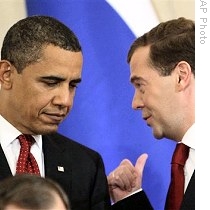Washington, D.C
14 July 2009
Arms control was one of the key issues discussed at the recent summit in Moscow between U.S. President Barack Obama and his Russian counterpart, Dmitri Medvedev. We look at the preliminary agreement reached to reduce both countries' strategic - or long-range - nuclear arsenals.
 |
| President Barack Obama and Russia's President Dmitry Medvedev, right, before they signed a preliminary agreement in Moscow, 06 Jul 2009 |
The START One treaty was negotiated in the 1980s, signed in 1991 by U.S. President George Herbert Walker Bush and Soviet leader Mikhail Gorbachev and came into force in 1994. It is one of the most complex treaties in history dealing with reducing nuclear weapons.
Daryll Kimball, Executive Director of the Arms Control Association, a private, independent organization, describes the current strategic nuclear arsenals of both countries.
"The United States claims that it has 2,200 strategic nuclear warheads deployed. Those are deployed on approximately 1,100 strategic delivery systems - land-based, sea-based missiles and heavy bombers. Russia's numbers are a little different. Russia has approximately 2,600-2,700 deployed strategic warheads right now, but on a much smaller number of delivery systems - probably around the 700 delivery system range," said Kimball.
Leaders agree to reduce stockpiles
Steve Andreasen, a national security and arms control expert at the University of Minnesota, says Presidents Obama and Medvedev agreed to lower those numbers.
"They agreed that in terms of strategic nuclear warheads to be limited, the two sides would basically work to get to a range of 1,500 to 1,675 warheads on both sides. And they also agreed that on the question of limiting nuclear delivery vehicles, they would agree to limitations in a range between 500 and 1,100," said Andreasen. "And so by agreeing to set those ranges, they've given their negotiators a sense of direction and also a sense of what the outcome needs to be in terms of acceptable parameters for this new follow-on accord."
Many experts, including Marshall Goldman from Harvard University, say the agreement reached in Moscow is modest.
"The important thing is that they had an agreement so that the whole issue did not blow up, so to speak," said Goldman. "Because if they hadn't reached an agreement, then the whole thing couldn't have been resolved and we could have found ourselves back with an arms race, which would not be, I think, in the interest of either country. So modest - but at least keep the thing going."
Despite the fact that both sides reached a preliminary accord, experts say much needs to be done to overcome obstacles to reaching a mutually-acceptable arms control treaty.
Steve Andreasen says there are a number of stumbling blocks, starting with which verification provisions of the START-One treaty will be incorporated in the new accord.
"And then secondly, the negotiators have been given instructions as to how many warheads and how many launchers to be counted in this new agreement - that is a range between 500 and 1,100 launchers and 1,500 to 1,675 warheads," he added. "But how you actually count to get to those numbers, that is what they call the 'counting rules' in arms control: how many warheads will be attributed to launchers and what launchers to count - that is those that are only operationally deployed or potentially others - those are still issues to be worked out in the negotiations."
New treaty to be ready by December
Arms control negotiators are racing against the clock to get the new treaty done by the December 5 deadline. Andreasen says to enter into force the new pact will have to be ratified by the Russian parliament - or Duma - and the U.S. Senate.
"The timeline is extremely short in terms of completing a new follow-on agreement. And then, for example in the United States, having the Senate hold hearings in the relevant committees and actually have a vote on ratification," said Andreasen. "And in order to get that done by December, you might hypothesize that a new accord would have to be concluded say no later than late September or early October. So that's a tall order."
Daryll Kimball from the Arms Control Association says it is doubtful the ratification deadlines will be met.
"And so that will mean that they will have to, at a later point, negotiate some sort of bridging arrangement to make sure that essential verification and monitoring provisions from the 1991 START treaty continue until such time as a new agreement - the START follow-on - enters into force," said Kimball.
Experts say another possibility would simply be to extend the START One treaty, which will be eventually superseded by the new accord when it is completed.